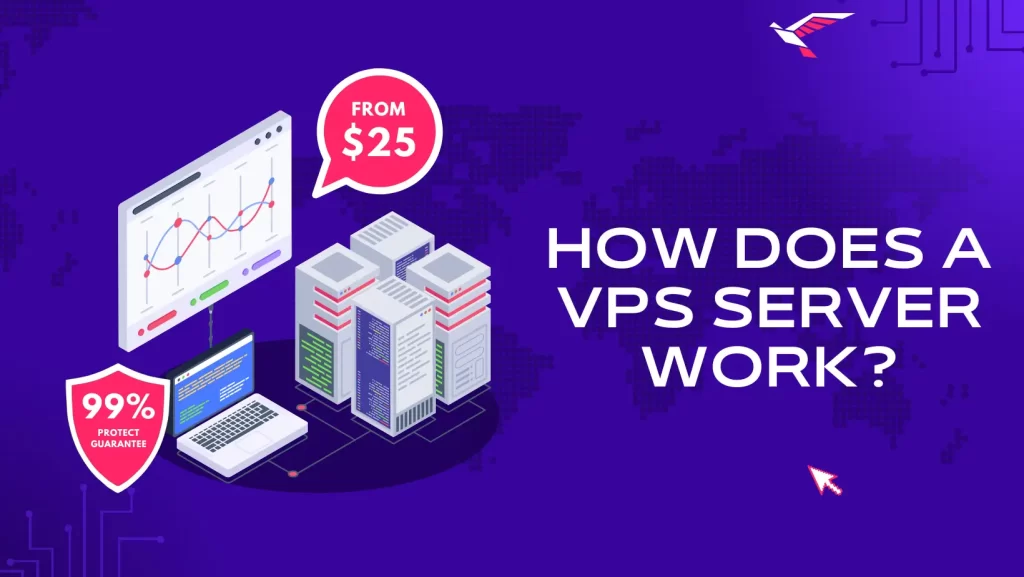A VPS (Virtual Private Server) is a popular hosting option that provides users with their own virtual server environment at an affordable cost. A VPS provides more features and flexibility than shared hosting but is more economical than a dedicated physical server. But how exactly does a VPS server work? Let’s take a look under the hood.
What is a VPS Server
A VPS is a virtual machine that runs its own copy of an operating system within a physical server. The physical server’s resources, like CPU cores, RAM, and storage get divided between multiple VPS instances through a process called virtualization. Each VPS then runs independently just like a standalone server.
Some key things to know about VPS servers:
- They run on top of a physical server that gets split into separate VPS instances.
- Each VPS instance runs its own OS copy and has dedicated resources allocated to it.
- VPS instances are isolated and do not interfere with each other’s operations.
- Users have full root access and control over their VPS just like a dedicated server.
Now let’s look at how these isolated VPS environments get created inside a physical server.
Best Locations for a VPS Server
- Switzerland has built a reputation as a privacy haven and hosts some of the world’s most secure data centers due to its strict data protection laws and high-quality infrastructure. Swiss vps data centers operate under top-notch standards for reliability. Popular VPS providers like Vultr, OVHcloud, and InterServer have data centers located in Switzerland making it an ideal location to host applications with a global audience.
- The Netherlands hosts one of the worlds largest connectivity hubs with major fiber links connecting it straight to the European backbone. Coupled with favorable data center regulations, reliable infrastructure, renewable energy sources, and competitive connectivity prices make Netherlands a top global VPS hosting choice.
- Singapore has emerged as Asia’s data center hub with world-class facilities and connectivity links boosting tremendous growth. Singapore offers fast local & international data transfer speeds, high service availability, robust cybersecurity, and political stability – all contributing to its popularity for VPS hosting among Asian customers.
How Does a VPS Server Work
A VPS server works using virtualization technology that allows abstraction and partitioning of a physical server into multiple isolated virtual machines. Here is a step-by-step overview:
The Hypervisor
The secret sauce that makes VPS hosting possible is the hypervisor software that virtualizes the underlying physical hardware. A Type-1 bare metal hypervisor gets installed directly on top of the server hardware to manage virtualization.
Popular hypervisor software solutions include VMware ESXi, Microsoft Hyper-V, Linux KVM, etc. The hypervisor partitions the available resources of the physical machine into isolated sections that can be assigned as VPS instances.
Resource Allocation
Once the hypervisor creates virtual partitions, the hosting provider allocates storage space, RAM, and CPU cores from the physical resources to each VPS instance.
The allocated compute resources are guaranteed and dedicated exclusively to that particular VPS server. This helps deliver consistent performance.
The provider can configure different sizes of VPS plans with varying amounts of resources according to customer requirements. More resources mean better VPS performance.
Operating System Installation
With the resources configured and isolated, the desired operating system gets installed on each virtual partition. Popular OS choices include Linux distros like CentOS, Ubuntu, Debian as well as Windows Server.
The OS behaves as if it was installed on an independent physical machine. All the standard server operations of the OS work normally on the virtualized hardware environment allocated to that VPS.
Management Interface
Finally, users are provided access to their isolated VPS instance to start configuration, installation of apps, and management. An IP address gets assigned to each VPS to connect over the network.
Users can access their VPS through a control panel like cPanel, Plesk, or just the command line to start building, deploying, and managing applications how they want just like a dedicated server.
Final Thoughts
A VPS server leverages virtualization to carve out a virtual machine with dedicated resources from a shared physical server. This provides users greater control, customization, and guaranteed performance similar to a dedicated server but at affordable costs.
Understanding how VPS hosting works helps select reliable providers that can meet application hosting needs with optimal server locations. A well-configured VPS with adequate compute resources offers the best of both worlds – cost savings and performance.
